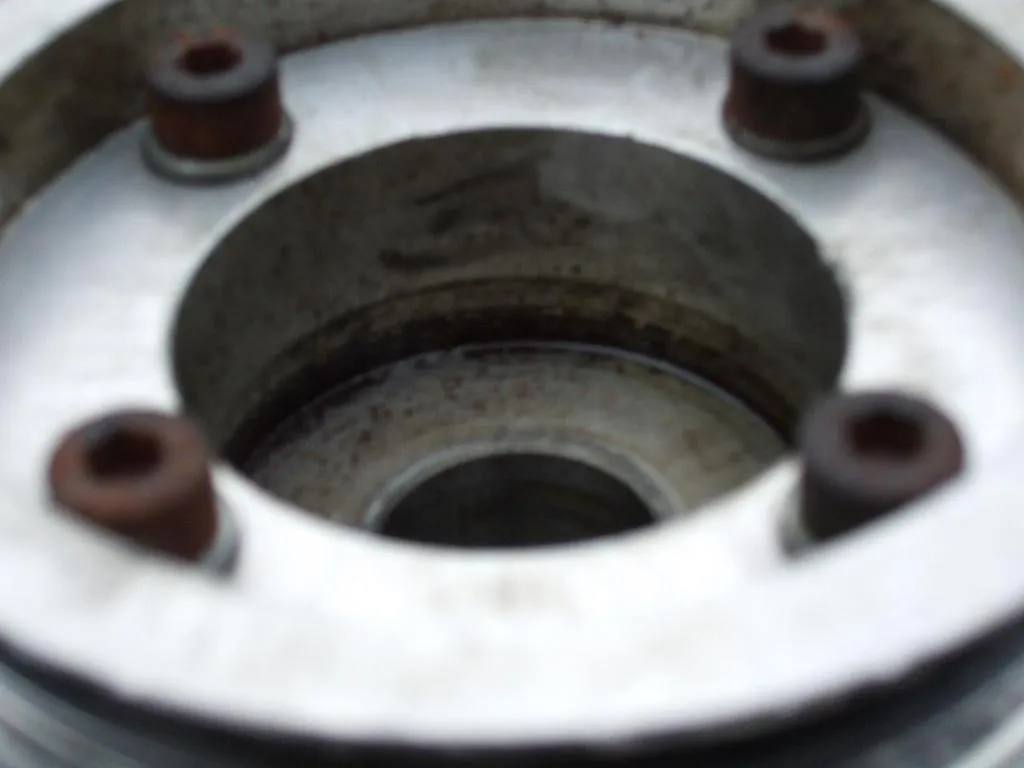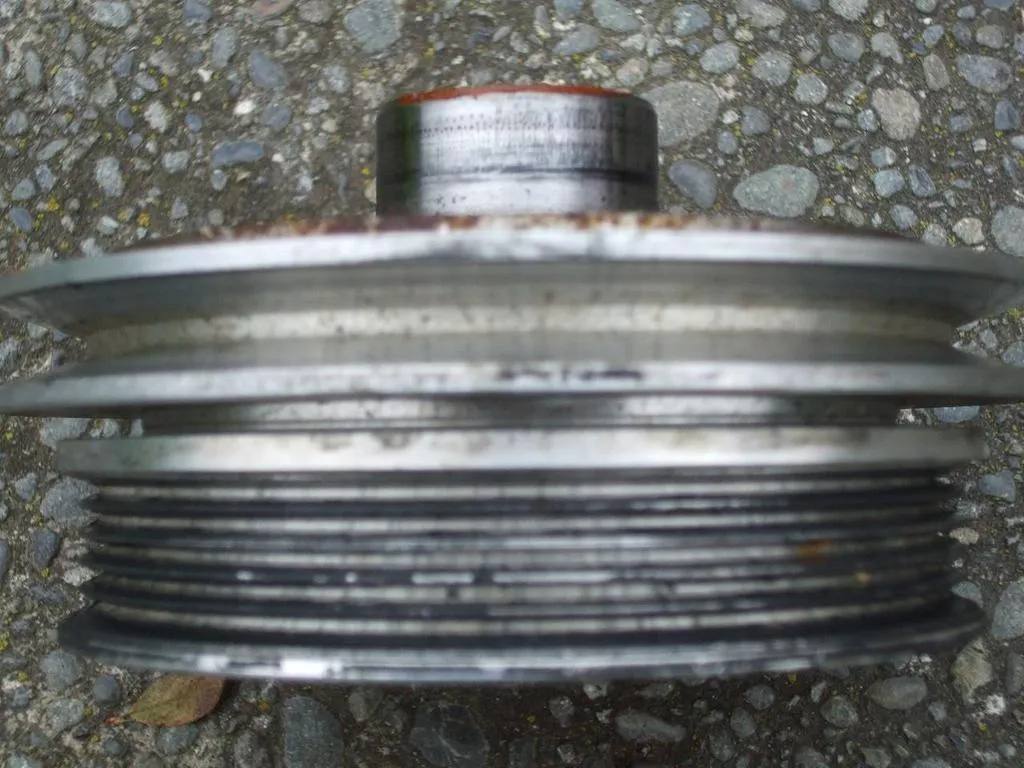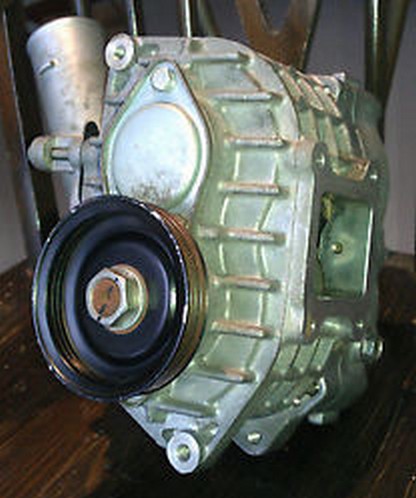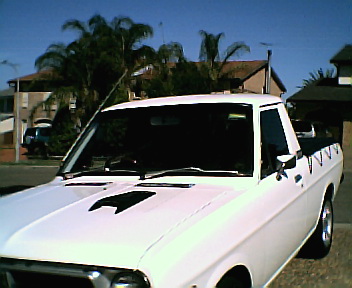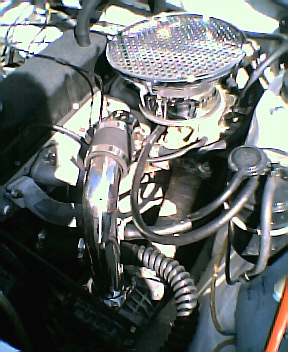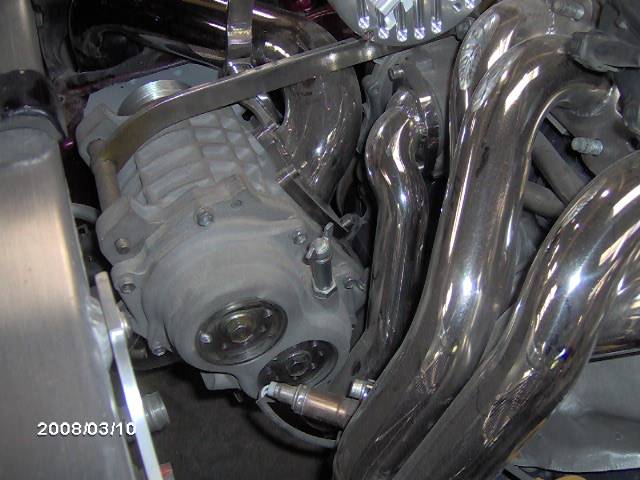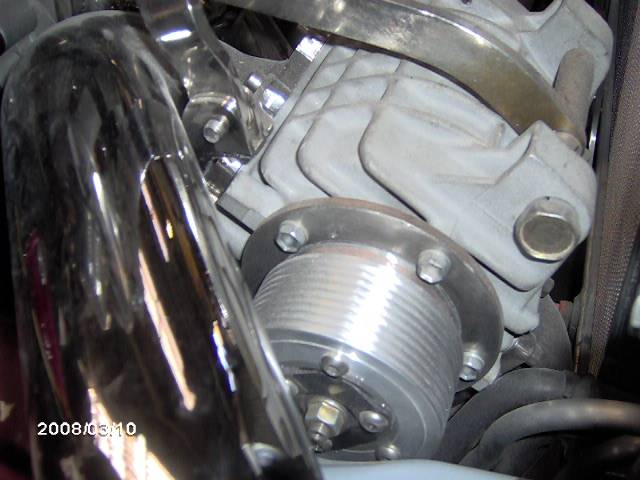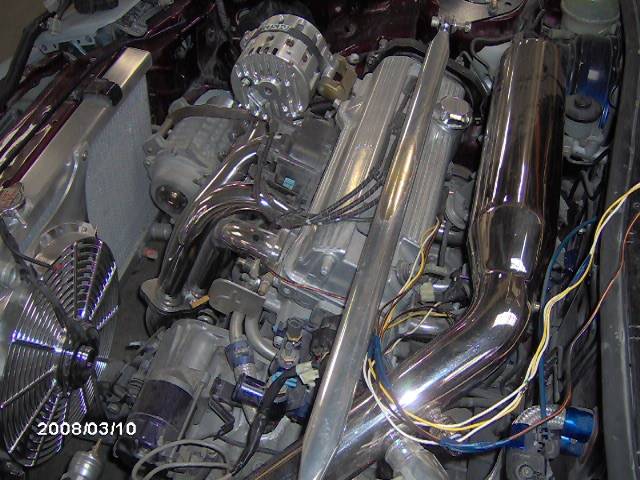| Revision as of 08:36, 18 December 2009 ddgonzal (Talk | contribs) <- Previous diff |
Current revision ddgonzal (Talk | contribs) (->Crank Pulley For Supercharger Drive) |
||
| Line 1: | Line 1: | ||
| Forced Induction comes in two forms: Supercharging and Turbo-supercharging. Both work well in a Datsun 1200! | Forced Induction comes in two forms: Supercharging and Turbo-supercharging. Both work well in a Datsun 1200! | ||
| + | |||
| + | {{Album!|9590}} | ||
| = Overview = | = Overview = | ||
| - | |||
| - | discussion: [http://datsun1200.com/modules/newbb/viewtopic.php?mode=viewtopic&topic_id=9997&forum=1 s/charged a14] | ||
| - | |||
| One thing to remember is that '''a method that works well''' isn't the '''only''' good way. | One thing to remember is that '''a method that works well''' isn't the '''only''' good way. | ||
| - | <blockquote>[http://datsun1200.com/modules/newbb/viewtopic.php?topic_id=13956&forum=3 Wuote:]<hr>Forced induction. | + | <blockquote><hr>[{{Post|59074}} Dodgeman]: Forced induction. This is a subject that was vigorously & robustly debated in an extensive thread not so long ago, so have a play with the search function & you will likely find it. |
| - | This is a subject that was vigorously & robustly debated in an extensive thread not so long ago, so have a play with the search function & you will likely find it. | + | |
| Myself, & a few others prefered the ability of the positive displacement blower to deliver high levels of torque, almost instantly, at very low engine speeds, while a large number of others prefered the advantages that a turbo offers at higher engine speeds. | Myself, & a few others prefered the ability of the positive displacement blower to deliver high levels of torque, almost instantly, at very low engine speeds, while a large number of others prefered the advantages that a turbo offers at higher engine speeds. | ||
| The turbo debate was further broken down into blow through versus suck through. | The turbo debate was further broken down into blow through versus suck through. | ||
| - | See if you can find this thread & have a read through it all. With some luck ou will gain an insight of the advantaged & disadvantages offered by each system.<hr> | + | See if you can find this thread & have a read through it all. With some luck ou will gain an insight of the advantaged & disadvantages offered by each system. |
| - | </blockquote> | + | <blockquote><hr>A15: what to do turbo or supercharge? |
| + | |||
| + | * Should I swap the A15 1.5-liter for an L20B 2-liter? Or just turbo the A15? | ||
| + | * What will it cost? | ||
| + | * Will it be as fast as a common V8 ute?</blockquote></blockquote> | ||
| The big discussion: [http://datsun1200.com/modules/newbb/viewtopic.php?mode=viewtopic&topic_id=6428&forum=1 regarding Turbocharging A12]. Caution: difficult reading in that discussion. | The big discussion: [http://datsun1200.com/modules/newbb/viewtopic.php?mode=viewtopic&topic_id=6428&forum=1 regarding Turbocharging A12]. Caution: difficult reading in that discussion. | ||
| + | |||
| + | Also see discussion: [http://datsun1200.com/modules/newbb/viewtopic.php?mode=viewtopic&topic_id=9997&forum=1 s/charged a14] (10 pages) | ||
| + | |||
| + | * Yes, an engine swap is easier & less expensive than forced induction. A $600 engine swap can be done in a weekend | ||
| + | * Forced induction can be done for about $1200 if you can do all the work yourself (including buying a used compressor and creating/fabricating the kit) | ||
| + | * Yes, forced induction on an A15 can be just as fast as a common V8 sedan, the 2-liter engine swap will not be | ||
| = Supercharging vs. Turbocharging -- what's better? = | = Supercharging vs. Turbocharging -- what's better? = | ||
| - | Section under construction. Volunteers? You gotta present both sides. | + | A supercharger does not suffer from lag like a turbo does. The power increase is immediate because a supercharger is driven from the crankshaft of the engine. The turbo is better for maximum HP, the blower is better maximum torque. F1 engines used turbos instead of blowers (turbos were allowed in certain years, banned in other years). |
| + | |||
| + | See main article: [[Turbo]] | ||
| + | |||
| + | Generally speaking a centrifugal compressor requires revving the engine up. as the engine revs higher, turbocharging makes more and more power. So does centrifugal supercharging (Paxton, Vortech, PowerDyne, Procharger, etc.). | ||
| + | |||
| + | By contrast, a positive-displacement compressor makes power all through the RPM range and so makes the engine feel like a larger displacement engine. This includes roots-type blowers and screw-chargers. The blower requires HP to run, so the engine must be built stronger than a turbo motor of equal HP. | ||
| + | |||
| + | * Turbo: Less expensive, more HP. More complicated. Welding skills required | ||
| + | * Blower: More responsive. Easier to install. Fabricating skills important if a kit is not available | ||
| + | * twin-charged: blower for low RPMs, turbo for the rest. See [[A12RTT]] | ||
| + | |||
| + | Because there are no bolt-on kits available for Datsun 1200 (as of 2014), neither one is 'better'. Either pay a shop $$$ to convert your engine, or use your skills and time to do the same on the cheap. Either way the result is a lot more HP for less money than a traditional [[Engine buildup]]. | ||
| + | |||
| + | Centrifugal Compressors: Paxton blower & turbo | ||
| + | <br>{{UploadH|174_574bf0f8d992b.jpg|192}} {{AlbumH|17698}} | ||
| + | |||
| + | All have been used in Datsun 1200s, as these photos show. | ||
| - | [http://datsun1200.com/modules/myalbum/photo.php?lid=94 http://datsun1200.com/modules/myalbum/thumbs/photos/94.jpg] | + | {{Thumb|94}} |
| B&M blown A14 (rootes-type supercharger) | B&M blown A14 (rootes-type supercharger) | ||
| - | [http://datsun1200.com/modules/myalbum/photo.php?lid=825 http://datsun1200.com/modules/myalbum/photos/thumbs/825.jpg] | + | {{Thumb|825}} |
| B&M supercharged NAPS-Z engine (rootes-type blower) | B&M supercharged NAPS-Z engine (rootes-type blower) | ||
| - | [http://datsun1200.com/modules/myalbum/photo.php?lid=634 http://datsun1200.com/modules/myalbum/photos/thumbs/634.jpg] | + | {{Thumb|634}} A14 supercharged |
| - | Centrifugal supercharger (belt-driven turbine) | + | |
| - | [http://datsun1200.com/modules/myalbum/photo.php?lid=602 http://datsun1200.com/modules/myalbum/photos/thumbs/544.jpg] | + | {{Thumb|544}} |
| Compound Supercharging concept | Compound Supercharging concept | ||
| - | [http://datsun1200.com/modules/myalbum/photo.php?lid=248 http://datsun1200.com/modules/myalbum/photos/thumbs/248.jpg] | + | {{Thumb|248}} |
| Twin-Turbo A12 | Twin-Turbo A12 | ||
| - | = Draw-through or blow-through turbo systems? = | + | {{Thumb|21898}} Supercharged A15 twincharger |
| - | Section by [http://datsun1200.com/userinfo.php?uid=596 datto_dave] | + | |
| - | The carburettor can be mounted in two positions on a turbo-charged engine, and a great deal of controversy exists as to which is better. The carburettor can me mounted such that it feeds air into the turbo then the turbo feeds it to the engine. This is known as a Draw-Through system.Under these conditions the carburettor operates more or less as it would on a naturally asperated engine. Another school of thought says that the carburettor should be mounted between the turbocharger and the intake manifold. This means that the turbocharger draws fresh air and pumps it into the carburettor, which then feeds the fuel/air mixture to the engine. This setup allows the use of an intercooler, which draw-through does not. In fact there are several advantages to a blow through over a draw through, because the fuel/air does not have to travel through the turbo. The blow through system requires a boost sensitive rising rate fuel pressure regulator in order to increase fuel pressure with boost pressure as the rpms rise. | + | = Draw-through vs Blow-through = |
| + | You can put the carburetor before the blower (draw-through) or after the blower (blow-through). Both work well. | ||
| - | [http://datsun1200.com/modules/myalbum/photo.php?lid=519 http://datsun1200.com/modules/myalbum/photos/thumbs/519.jpg] | + | * Draw-through places the carburetor in the normal position (same as naturally-aspirated). A larger carburetor is needed to make more power, and the jetting should be richened up to handle full-throttle operation |
| - | Blow-through system | + | |
| - | Another snag to the blow-through system is that the carburettor must be enclosed in a pressure box and the fuel supplied to the carburettor must be at a suitable pressure above the boost pressure. This means the fuel pressure has to be regulated in accordance with the boost pressure at all times. My own personal preference to date has been for the draw-through system this is largely substantiated by other people in the industry who are running very high-powered turbocharged cars. Almost all are using draw-through systems. However, the speed equipment industry doesn | + | * Blow-through places the carburetor in the boost side, so it must be modified to handle this boosted condition. The floats must be non-crushable type, and the carburetor sealed against air leaks. Jetting using calls for radical changes |
| + | |||
| + | = Engine Build = | ||
| + | A stock A12 can make up to 160HP - with stock rods, stock pistons, stock head gasket -- when powered up by a [[turbo]]. If the same output is gained by revving the engine higher (naturally aspirated), the rods & pistons must be upgraded. If 160HP is made by Supercharging, the engine should be upgraded with forged pistons and stronger rods to handle the load of the blower. | ||
| + | |||
| + | The most important part of forced induction is Spark Control. If you keep the spark backed off, the engine will not self-destruct. At the most basic this means limiting the distributor [[Spark Curve]]. | ||
| + | |||
| + | = Spark Curve = | ||
| + | {{Spark Curve}} | ||
| = Intercooler = | = Intercooler = | ||
| - | An Intercooler is not needed. The first three years of the Porsche 911 Turbo didn't have one (75-77), yet this 3.0 liter turbo outperformed 7.5 liter NA cars. However there are very good reasons to use an intercooler, including: | + | An intercooler can result in far more HP, but requires a blow-through system (boxed carburetor) or EFI port injection. This is because for safety you don't want air-fuel mixture going through the cooler, where it will condense out of the airstream and result in fuel puddles in the cooler! |
| - | * Intercooler is worth it as it significantly reduces the temperature of the compressed air, which increases the boost possible with a given octane fuel | + | By keeping the air cool and therefore dense, the same boost will make more HP, because more air is entering the engine. Because it's not overheated, more spark advance can be applied for more HP. |
| - | * Using an aluminum radiator should be better than nothing. Unless someone actually tested this, we are all just guessing. Radiators can flow a lot of water, and air is easier to pump ... so air should flow through w/o significant restriction. Putting this in front of the car should allow some cooling effect, although obviously not as a much as a purpose-designed cooler. | + | |
| - | * An alternative is to use water or alcohol injection. Some OEM applications used water injection (ex. 1962 Oldsmobile Jetfire) | + | |
| - | = Wastegate = | + | {{SeeMainArticle!|Intercooler}} |
| - | A Wastegate is used for adjustable control over boost pressure. When the set pressure is exceeded, exhaust is routed around the turbine to go out the tailpipe | + | |
| - | * Not needed if you carefully size the turbo to the application (ensuring that at maximum rpm, design boost is not exceeded). Older OEM applications used this method. | + | |
| - | = Blow-off valve (or recirculation valve) = | + | = Boost pressure = |
| - | A Blow-off valve is used to preventin the turbo from surging, for example during gear shift or whenever throttle is closed. Porsche uses these, so obviously they work. | + | * 6-7 psi is what a lot of OEM applications use. |
| + | * 10 psi is reliable with a stock A12 or A14 | ||
| + | * 14.7 lbs gives theoretically double the airflow so max. power would be about 2x stock, but this isn't actually the result. The reason is that the stock induction and exhaust system won't flow this much air under pressure. However, the low rpm torque could approach 2x (at about 2250 rpm) if a small blower is used. So a 130hp forced induction engine will have much more performance than a 130hp NA engine | ||
| - | * Blow-off intake boost to atmosphere. Boost is lost. Simple, inexpensive | + | = Induction and Exhaust = |
| - | * Blow-off to compressor inlet (recirculate back through turbo inlet). Used to enhance throttle response: Boost is kept in circuit for immediate availability when throttle is opened again | + | Obvious, to obtain more airflow, a higher flowing carb, intake, heads (ports and valves) and exhaust system is beneficial. |
| - | = Carburetor Setup = | + | Supercharging will increase power on a stock engine, even one with no mods. But increasing the airflow capability of the engine will bring your blown engine to its full potential. |
| - | * Injection is better, allowing better control of mixture | + | |
| - | * Draw through was used by many OEM setups. It is reliable, and the simplest option. The downside is you can't use an intercooler, as the fuel will condense in the cooler. | + | |
| - | * Blow through works well. The main reason to use this over a draw-through is so an intercooler can be used. | + | |
| - | ** Boxing carb. This allows a more or less stock carb to be used, the outsided pressure balancing the inside pressure | + | |
| - | ** Unboxed carb. This was a popular OEM method. phunkdotaspok says this can handle 10 psi with a good top-gasket seal. In an NA application, a warped top is not a problem, as there is no pressure in the float chamber. This only becomes important in boosted application. | + | |
| - | **: [http://datsun1200.com/modules/myalbum/photo.php?lid=535 http://datsun1200.com/modules/myalbum/photos/thumbs/535.jpg] Inside the box | + | |
| - | * Need richer jets to keep air charge cool and prevent detonation | + | |
| - | = Fuel pump = | + | = Rootes = |
| - | * Stock fuel pump is good for draw-through setup. It's not enough for a blow-through setup, as 2.5 boost would overpower the fuel pressure | + | {{SeeMainArticle!|Blown 1200s}} |
| - | * Using a low-pressure (15 psi) electric pump oughta be good for a 10-12.5 psi boost. | + | |
| - | * Needle and seat has trouble holding more than 10 psi fuel pressure. Better to use a secondary 15-psi pump to cut in only when needed. | + | |
| - | * Best setup is to use a rising-rate regulator with a high-psi pump. Excess fuel is returned to the tank. | + | |
| - | [http://datsun1200.com/modules/myalbum/photo.php?lid=564 http://datsun1200.com/modules/myalbum/photos/thumbs/564.gif] | + | {{ThumbH!|24625}} {{ThumbH!|24626}} {{ThumbH!|24627}} |
| - | Fuel regulator | + | |
| - | = Turbochargers = | + | = Centrifugal = |
| - | * T3 is pretty big for an A12. Needs high rpm, head work, etc | + | * Paxton (as of 2016) only makes high-HP blowers (smallest is 775 HP) |
| - | * Mid-80s Nissan Pulsar turbo (E15 engine) has integral wastegate | + | * Vortech's smallest (V5) is up to 450 hp output |
| - | * go_the_datto actually tried '''Daihatsu diesel 1.0 turbo''' on A12. Good response in lower rpm ranges. Two make better twin-turbo application for A12 | + | * Powerdyne seems out of business |
| - | Here is some helpful info on everything from how a turbo works to choosing the right turbo for your engine based on '''compressor maps''' | + | Procharger makes blowers suitable for A-series: |
| - | [http://www.turbobygarrett.com/turbobygarrett/tech_center/tech_center.html Turbo Tech] | + | * A-1P up to 100 HP is for engines of base 25-75 hp |
| + | * A1-R up to 150 HP is for 50-95 HP engines | ||
| + | * B1 up to 250 HP is for 60-150 HP engines | ||
| - | = Diesel vs. Petrol Turbos = | + | These are about the size of a large alternator, and have serpentine belt pulleys. |
| - | Barpk: The main difference between a petrol and diesel turbo is its seals. Diesel turbos don't have positive seal turbo seals, which means that if put it in a suck-through system they can leak oil under extreme vacuum, which happens when throttle is closed. This is not a problem in a blow-through system. | + | = Crank Pulley For Supercharger Drive = |
| + | The factory pulleys have a bad habit of cracking through the keyway. Use a custom one with a steel crank hub. | ||
| - | = Boost pressure = | + | http://www.kemotorsport.com Datsun A-SERIES Supercharger pulley 6rib+V $140 posted |
| - | * 6-7 psi is what a lot of OEM applications use. | + | <br>{{Album|27151}} |
| - | * 10 psi should be possible with a stock A12/A14 | + | |
| - | * 14.7 lbs gives theoretically double the airflow so max. power would be about 2x stock, but this isn't actually the result. The reason is that the stock induction and exhaust system won't flow this much air under pressure. However, the low rpm torque could approach 2x (at about 2250 rpm) if a small turbo is used. So a 130hp turbo engine will have much more performance than a 130hp NA engine | + | |
| - | * 1986 Honda 1.5 liter ran boost of 4.0 bar - that's 300 bhp ... per cylinder with special fuel | + | |
| - | [http://datsun1200.com/modules/myalbum/photo.php?lid=527 http://datsun1200.com/modules/myalbum/photos/thumbs/527.jpg] | + | [{{Post|320617}} Supercharger Dilemma] |
| + | <br>{{UploadPost|174_659cf31d289d6.jpg|498161|was=PhotoPost\pulley6.jpg\320617}} {{UploadPost|174_659cf326d3470.jpg|498161|was=PhotoPost\pulley7.jpg\320617}} | ||
| - | = Induction and Exhaust = | + | = Supercharger Setups = |
| - | Obvious, for more airflow, a higher flowing carb, intake, heads (ports and valves) and exhaust system is beneficial. | + | Autospeed article: [http://www.autospeed.com/cms/article.html?&title=Supercharger-Steal-Part-One&A=110294 Supercharger Steal - A look at the second-hand superchargers on the market] |
| + | |||
| + | [http://datsun1200.com/modules/newbb/viewtopic.php?topic_id=555&forum=1 4AGEZ supercharged] from the MR2. | ||
| + | |||
| + | == Possum1200 == | ||
| + | Possum bought this 1200 with dry sump, then sold the blower to revhead | ||
| + | |||
| + | {{Album|17707}} {{Album|17633}} | ||
| + | |||
| + | == Mercedes == | ||
| + | Mercedes blower by Eaton (w/o clutch) | Eaton M45 | ||
| + | <br>{{Album|7679}} {{Album|21901}} | ||
| + | |||
| + | === datsa73 === | ||
| + | {{Main|datsa73}} | ||
| + | |||
| + | Mercedes Kompressor-boosted Datsun 1200 (with OEM electric clutch) | ||
| + | <br>{{Album!|19225}} | ||
| + | |||
| + | == AMR == | ||
| + | === Wally === | ||
| + | See [[Wally's Wagon: A Supercharged Super Car]] with AMR300 blower | ||
| + | |||
| + | {{Album!|635}} {{Album!|602}} | ||
| + | |||
| + | === AMR500 === | ||
| + | Made by Aisin. Larger than the tiny AMR300 found on Subarus. Found on Nissan March with MA09S engine | ||
| + | |||
| + | AMR500 | ||
| + | <br>{{Upload|737_52a46b422d62f.jpg}} | ||
| - | Supercharging will increase power on a stock engine, but increasing the airflow capability of the engine will bring your blown engine to its full potential | + | http://www.kemotorsport.com kit for A12 |
| + | <br>{{Album|27153}} | ||
| - | This factory A14 forklift exhaust manifold might be useful: | + | [{{Post|451883}} A12iR Project (i=injection, R=supercharged)] |
| - | * [http://datsun1200.com/modules/myalbum/photo.php?lid=1090 http://datsun1200.com/modules/myalbum/photos/thumbs/1090.jpg] | + | GM sensors |
| + | AMR500 Supercharger | ||
| + | {{UploadPost|12954_530757705943b.jpg|451883}} | ||
| - | [http://datsun1200.com/modules/myalbum/photo.php?lid=921 http://datsun1200.com/modules/myalbum/photos/thumbs/921.jpg] | + | [http://khairul120y.blogspot.com/?zx=ed855a7d4fe532ee blog] |
| - | Turbo Camshaft specs | + | <br>{{Upload|737_4c0ccc8b8e716.jpg}} {{ExtPhoto|http://3.bp.blogspot.com/_NKiWydFcDKk/RxQejkJK9PI/AAAAAAAAAAU/XowLUkP3TFk/S220|RECO0075.JPG}} |
| - | [http://datsun1200.com/modules/myalbum/photo.php?lid=661 http://datsun1200.com/modules/myalbum/photos/thumbs/661.jpg] | + | === rogue === |
| - | Tuned-port Intake | + | AMR300 from Subaru Vivio with EN07Z 660cc-class (kei car) engine |
| - | [http://datsun1200.com/modules/myalbum/photo.php?lid=301 http://datsun1200.com/modules/myalbum/photos/thumbs/301.JPG] | + | See Main Article: [[Rogue]] |
| - | UM-1 Manifold | + | |
| - | [http://datsun1200.com/modules/myalbum/photo.php?lid=652 http://datsun1200.com/modules/myalbum/photos/thumbs/652.jpg] | + | {{Album!|6168}} {{AlbumH|6171|jpg|288}} |
| - | Ram plenum manifold | + | |
| - | [http://datsun1200.com/modules/myalbum/photo.php?lid=518 http://datsun1200.com/modules/myalbum/photos/thumbs/518.jpg] | + | == SC12 == |
| - | Exhaust manifold idea | + | Toyota SC12 supercharger |
| - | [http://datsun1200.com/modules/myalbum/photo.php?lid=653 http://datsun1200.com/modules/myalbum/photos/thumbs/653.jpg] | + | {{Album|15590}} {{Album|15591}} {{Album|15592}} |
| - | Exhaust flange | + | |
| - | = Factory Turbo Systems = | + | {{Album|4053}} |
| - | Might you spend less money and get more horsepower and reliability by swapping in a factory turbo moto? | + | |
| - | == Nissan Turbos == | + | === SC12 1200 === |
| - | [http://datsun1200.com/modules/myalbum/photo.php?lid=43 http://datsun1200.com/modules/myalbum/photos/thumbs/43.jpg] | + | See main article: [[SuperSedan]] |
| - | Z18T | + | |
| - | [http://datsun1200.com/modules/myalbum/photo.php?lid=91 http://datsun1200.com/modules/myalbum/photos/thumbs/91.jpg] | + | {{Album!|9590}} |
| - | CA18DET | + | |
| - | [http://datsun1200.com/modules/myalbum/photo.php?lid=106 CA18DET Magazine article] | + | |
| - | [http://datsun1200.com/modules/myalbum/photo.php?lid=111 http://datsun1200.com/modules/myalbum/photos/thumbs/111.jpg] | + | == SC14 == |
| - | SR20DET Magazine article | + | Toyota SC14 supercharger is the most popular blower swap for Datsun 1200s. |
| - | == Toyota 4A 1600cc engines == | + | {{SeeMainArticle|SC14|1051}} |
| - | * A15 Specs from the article written by Davo1200 (http://datsun1200.com/modules/nsections/index.php?op=printpage&artid=13) | + | |
| - | * 4A-FE Specs can be seen at redbook in a CS Seca for example (http://www.redbookasiapacific.com/au/vehicle/specs.php?key=TOYO90FZ) | + | |
| - | {| border="1" | + | == NZ2DR == |
| - | |+ Datsun A15 vs Toyota 4A-** | + | Blown A-series 2-dr from New Zealand |
| - | ! !! Datsun A15 !! Toyota 4A-FE !! Toyota 4A-GE (Gen 3) !! Toyota 4A-GZE (AE101) | + | <br>{{Album|25792}} |
| - | |- | + | |
| - | ! Bore | + | |
| - | | 76 mm || 81 mm || 81 mm || 81 mm | + | |
| - | |- | + | |
| - | ! Stroke | + | |
| - | | 82 mm || 77 mm || 77 mm || 77 mm | + | |
| - | |- | + | |
| - | ! Displacement | + | |
| - | | 1488 cc || 1587 cc || 1587 cc || 1587 cc | + | |
| - | |- | + | |
| - | ! Power | + | |
| - | | 81 hp (60 kW) || 89 hp (66 kW) || 138 hp (103 kW) || 168 hp (125 kW) | + | |
| - | |- | + | |
| - | |} | + | |
| + | == Blown 3800 == | ||
| + | [[3800|GM V6]] with supercharger in Datsun 1200 | ||
| + | <br>{{Album!|26200}} | ||
| - | Although some have been able to extract more power from the 4A-FE. The upside is that they are very easily obtainable and so are parts. They are a narrow angle DOHC (single sprocket) cross-flow alloy head with a cast iron block. | + | == blown1400 == |
| + | [{{Post|42397}} blown1400's ute for sale] | ||
| - | * [[Toyota 4A engine|4A-GE]] (wide angle DOHC) Come in 5 flavours ranging from 86kW (Gen 2) up to 121kW (Gen 5) 20 Valve. | + | Datsun 1200 Utility |
| - | * [http://datsun1200.com/modules/newbb/viewtopic.php?topic_id=555&forum=1 4A-GZE supercharged]. Some use this motor and its fuel system and computer for a turbo setup although simply replacing the cast pistons with forged items in a 4A-GE will yield the same result (except that an aftermarket ECU will be needed). The advantage over the supercharger is that boost can be variably controlled using and adjustable wastegate or boost controller. A supercharger has a fixed design boost, although aftermarket overdrive pulleys are available. They don't like to be spun more that around 8000 rpm as the teflon coatings on the roots can melt. | + | Supercharged a14 |
| + | Ross pistons | ||
| + | shot-peened valves, con-rods etc. | ||
| + | Water-injected supercharger sucks through a 2-inch SU | ||
| + | {{Thumb|3386}} {{Thumb|3387}} {{Thumb|3388}} {{Thumb|3389}} {{Album|3385}} | ||
| - | == Mazda Wankel Engine == | + | = Photo Index = |
| + | See [[Forced Induction A-series Photo Index]] | ||
| - | [[Category:Engine Modifications]] | + | [[Category:Forced Induction]]{{End}} |
Current revision
Forced Induction comes in two forms: Supercharging and Turbo-supercharging. Both work well in a Datsun 1200!

Contents |
Overview
One thing to remember is that a method that works well isn't the only good way.
POST Dodgeman: Forced induction. This is a subject that was vigorously & robustly debated in an extensive thread not so long ago, so have a play with the search function & you will likely find it.Myself, & a few others prefered the ability of the positive displacement blower to deliver high levels of torque, almost instantly, at very low engine speeds, while a large number of others prefered the advantages that a turbo offers at higher engine speeds. The turbo debate was further broken down into blow through versus suck through.
See if you can find this thread & have a read through it all. With some luck ou will gain an insight of the advantaged & disadvantages offered by each system.
A15: what to do turbo or supercharge?
- Should I swap the A15 1.5-liter for an L20B 2-liter? Or just turbo the A15?
- What will it cost?
- Will it be as fast as a common V8 ute?
The big discussion: regarding Turbocharging A12. Caution: difficult reading in that discussion.
Also see discussion: s/charged a14 (10 pages)
- Yes, an engine swap is easier & less expensive than forced induction. A $600 engine swap can be done in a weekend
- Forced induction can be done for about $1200 if you can do all the work yourself (including buying a used compressor and creating/fabricating the kit)
- Yes, forced induction on an A15 can be just as fast as a common V8 sedan, the 2-liter engine swap will not be
Supercharging vs. Turbocharging -- what's better?
A supercharger does not suffer from lag like a turbo does. The power increase is immediate because a supercharger is driven from the crankshaft of the engine. The turbo is better for maximum HP, the blower is better maximum torque. F1 engines used turbos instead of blowers (turbos were allowed in certain years, banned in other years).
See main article: Turbo
Generally speaking a centrifugal compressor requires revving the engine up. as the engine revs higher, turbocharging makes more and more power. So does centrifugal supercharging (Paxton, Vortech, PowerDyne, Procharger, etc.).
By contrast, a positive-displacement compressor makes power all through the RPM range and so makes the engine feel like a larger displacement engine. This includes roots-type blowers and screw-chargers. The blower requires HP to run, so the engine must be built stronger than a turbo motor of equal HP.
- Turbo: Less expensive, more HP. More complicated. Welding skills required
- Blower: More responsive. Easier to install. Fabricating skills important if a kit is not available
- twin-charged: blower for low RPMs, turbo for the rest. See A12RTT
Because there are no bolt-on kits available for Datsun 1200 (as of 2014), neither one is 'better'. Either pay a shop $$$ to convert your engine, or use your skills and time to do the same on the cheap. Either way the result is a lot more HP for less money than a traditional Engine buildup.
Centrifugal Compressors: Paxton blower & turbo


All have been used in Datsun 1200s, as these photos show.
 B&M blown A14 (rootes-type supercharger)
B&M blown A14 (rootes-type supercharger)
 B&M supercharged NAPS-Z engine (rootes-type blower)
B&M supercharged NAPS-Z engine (rootes-type blower)
 Compound Supercharging concept
Compound Supercharging concept
Draw-through vs Blow-through
You can put the carburetor before the blower (draw-through) or after the blower (blow-through). Both work well.
- Draw-through places the carburetor in the normal position (same as naturally-aspirated). A larger carburetor is needed to make more power, and the jetting should be richened up to handle full-throttle operation
- Blow-through places the carburetor in the boost side, so it must be modified to handle this boosted condition. The floats must be non-crushable type, and the carburetor sealed against air leaks. Jetting using calls for radical changes
Engine Build
A stock A12 can make up to 160HP - with stock rods, stock pistons, stock head gasket -- when powered up by a turbo. If the same output is gained by revving the engine higher (naturally aspirated), the rods & pistons must be upgraded. If 160HP is made by Supercharging, the engine should be upgraded with forged pistons and stronger rods to handle the load of the blower.
The most important part of forced induction is Spark Control. If you keep the spark backed off, the engine will not self-destruct. At the most basic this means limiting the distributor Spark Curve.
Spark Curve
The more compression, the less advance the engine can handle. But a high-compression engine can still use some advance, and even a forced-induction engine needs some advance to make the most power at varying RPMs. The key is LIMITING the advance to a safe level.
Consequences of too much spark advance: cracked pistons, broken ring lands
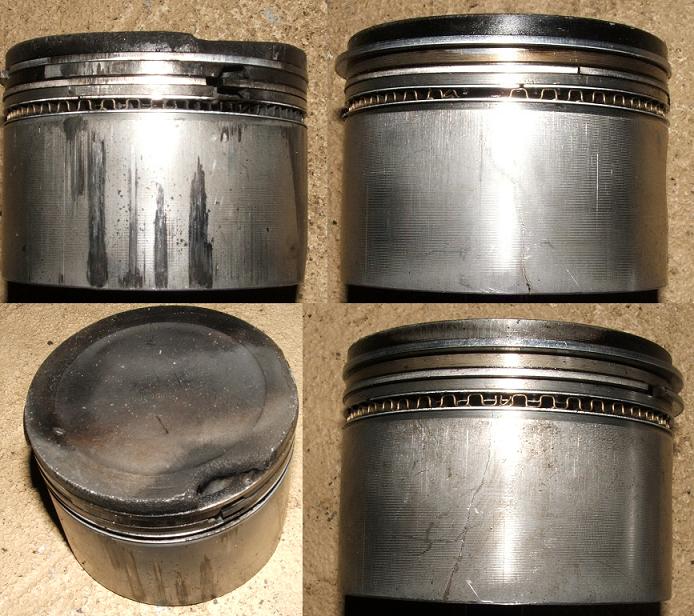

What about locking the distributor? Yes, if you lock the advance mechanism, yes, it can help prevent detonation, but also it won't make the best power. Locked distributor will only work great at high-RPM, high-boost condition -- which is where racers spend most of their time, so it works well for racing. For a street engine, you will have a more flexible, more powerful engine at all RPMs by NOT locking the distributor, but by limiting the advance.
CONSTANT-LOAD RACING METHOD
- Lock the distributor advance. Set full timing to an appropriate level, say 30 degrees for a high-compression engine or for maximum advance at 16 psi boost: 23 degrees.
LOW-DOLLAR STREET POWER METHOD
- In the distributor, weld the advance slots partially to limit mechanical advance (see Limiting Mechanical Advance)
- Keep the stock vacuum advance (it will have no effect under heavy throttle or boost)
- Connect vacuum advance up directly to manifold. This will help idle and starting out under low throttle, but the vacuum advance will have no effect under heavier throttle
- Set initial timing to lower than normal, say 3 degrees or 0 degrees (instead of the normal 5-7)
- Downside: On a forced-induction engine, the advance won't be right for varying boost levels. You'll have to set the advance for full boost scenario, giving up HP and fuel economy for lower throttle conditions such as highway cruising
BEST METHOD: fully programmable ignition
- use a crank trigger with a fully programmable ignition system. MegaSquirt and other ECUs can provide initial timing, limited full timing, timing under boost and even retard under boost and compensate for high temperatures.
- use a standalone advance controller like the Block Box or an MSD Programmable, which allows for limited mechanical advance along with variable retard under boost, off-boost, and partial-boost conditions. With such a controller, the distributor is locked, and the box takes over the exact timing curve.
Intercooler
An intercooler can result in far more HP, but requires a blow-through system (boxed carburetor) or EFI port injection. This is because for safety you don't want air-fuel mixture going through the cooler, where it will condense out of the airstream and result in fuel puddles in the cooler!
By keeping the air cool and therefore dense, the same boost will make more HP, because more air is entering the engine. Because it's not overheated, more spark advance can be applied for more HP.
Boost pressure
- 6-7 psi is what a lot of OEM applications use.
- 10 psi is reliable with a stock A12 or A14
- 14.7 lbs gives theoretically double the airflow so max. power would be about 2x stock, but this isn't actually the result. The reason is that the stock induction and exhaust system won't flow this much air under pressure. However, the low rpm torque could approach 2x (at about 2250 rpm) if a small blower is used. So a 130hp forced induction engine will have much more performance than a 130hp NA engine
Induction and Exhaust
Obvious, to obtain more airflow, a higher flowing carb, intake, heads (ports and valves) and exhaust system is beneficial.
Supercharging will increase power on a stock engine, even one with no mods. But increasing the airflow capability of the engine will bring your blown engine to its full potential.
Rootes
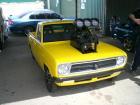
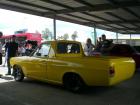
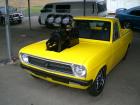
Centrifugal
* Paxton (as of 2016) only makes high-HP blowers (smallest is 775 HP) * Vortech's smallest (V5) is up to 450 hp output * Powerdyne seems out of business
Procharger makes blowers suitable for A-series: * A-1P up to 100 HP is for engines of base 25-75 hp * A1-R up to 150 HP is for 50-95 HP engines * B1 up to 250 HP is for 60-150 HP engines
These are about the size of a large alternator, and have serpentine belt pulleys.
Crank Pulley For Supercharger Drive
The factory pulleys have a bad habit of cracking through the keyway. Use a custom one with a steel crank hub.
http://www.kemotorsport.com Datsun A-SERIES Supercharger pulley 6rib+V $140 posted
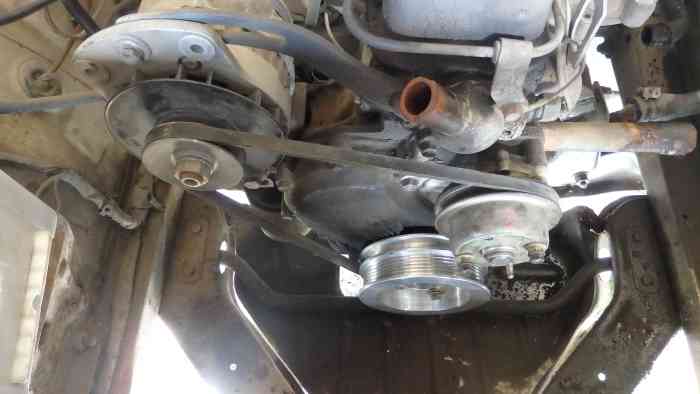
Supercharger Setups
Autospeed article: Supercharger Steal - A look at the second-hand superchargers on the market
4AGEZ supercharged from the MR2.
Possum1200
Possum bought this 1200 with dry sump, then sold the blower to revhead
Mercedes
Mercedes blower by Eaton (w/o clutch) | Eaton M45
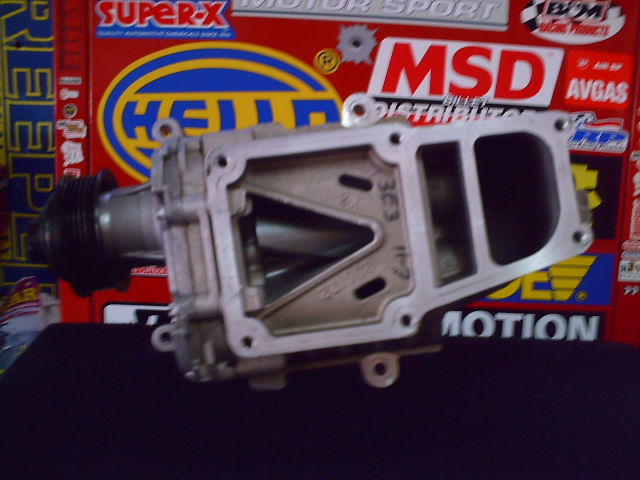
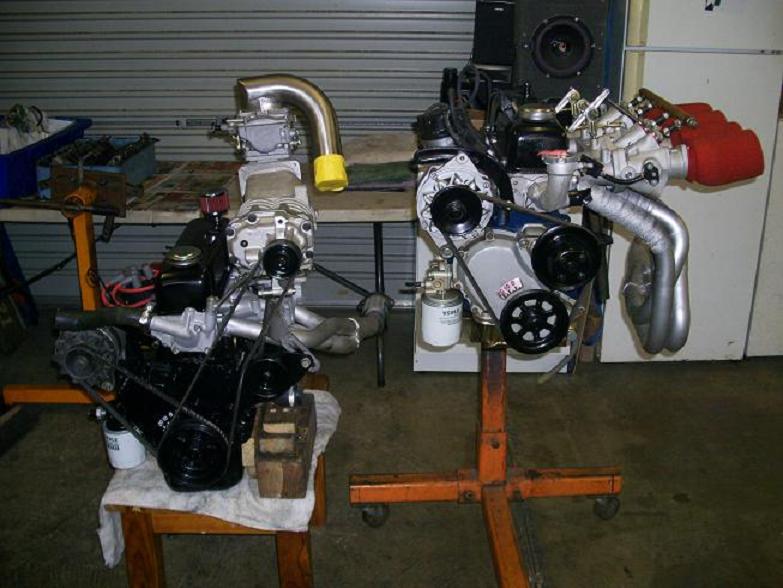
datsa73
Mercedes Kompressor-boosted Datsun 1200 (with OEM electric clutch)

AMR
Wally
See Wally's Wagon: A Supercharged Super Car with AMR300 blower


AMR500
Made by Aisin. Larger than the tiny AMR300 found on Subarus. Found on Nissan March with MA09S engine
http://www.kemotorsport.com kit for A12
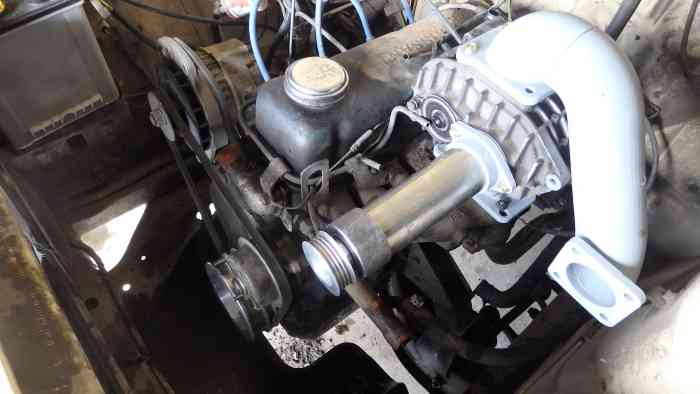
POST A12iR Project (i=injection, R=supercharged) GM sensors AMR500 Supercharger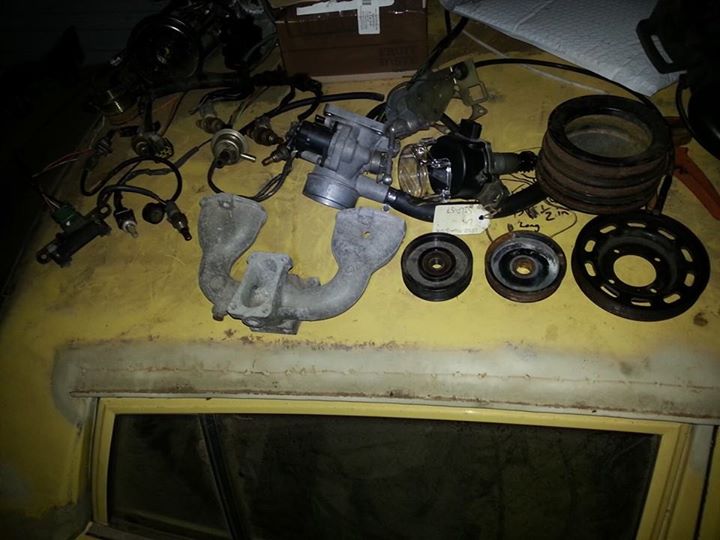
rogue
AMR300 from Subaru Vivio with EN07Z 660cc-class (kei car) engine
See Main Article: Rogue
SC12
Toyota SC12 supercharger
SC12 1200
See main article: SuperSedan

SC14
Toyota SC14 supercharger is the most popular blower swap for Datsun 1200s.
NZ2DR
Blown A-series 2-dr from New Zealand
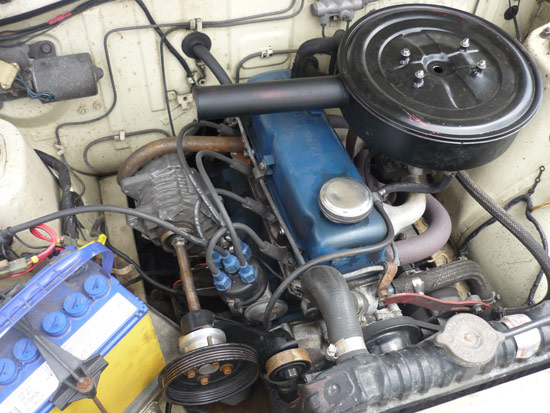
Blown 3800
GM V6 with supercharger in Datsun 1200
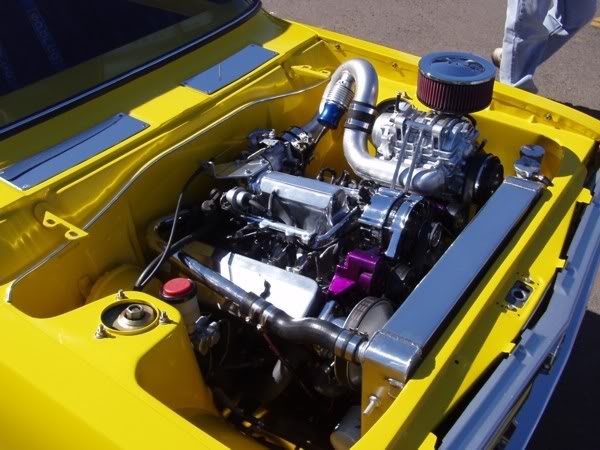
blown1400
Datsun 1200 Utility Supercharged a14 Ross pistons shot-peened valves, con-rods etc. Water-injected supercharger sucks through a 2-inch SU
Photo Index
See Forced Induction A-series Photo Index

![[Datsun 1200 encyclopedia]](/wiki/upload/wiki.png)



